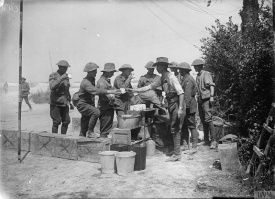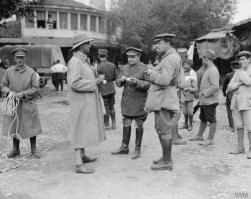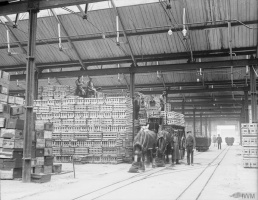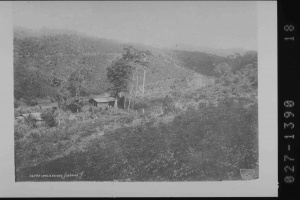Coffee before World War I↑
By the beginning of the 20th century, coffee had become a luxury item which, in the developed industrial countries of the north, was drunk regularly, although perhaps not daily or in pure form, by all classes of society, depending on national, regional, and individual customs. In Imperial Germany, annual per capita consumption was between 2.5 and 3 kilograms in the years before 1914. After World War I this level was not reached again until 1938, and after World War II not until 1958 (in the Federal Republic of Germany). The growing demand for coffee encouraged cultivation to expand, mainly in Brazil, which, before World War I, produced 75 percent of the world’s coffee beans. Coffee’s commodity chain was a complex and closely interconnected global system, which involved not only the countries of production and consumption, but also international centres of finance, most importantly the City of London, whose merchant banks financed the international trade in coffee.
Coffee at the Outbreak of War↑
The outbreak of World War I resulted in an immediate interruption of transatlantic trade. The European coffee exchanges closed. In countries involved in the war, stocks of coffee were impounded; the valorized Brazilian coffee that was stored in Hamburg was bought up by the German government.
In Britain, the Trading with the Enemy Act of 18 September 1914 forced all commercial banks in the City of London to break off business relations with the Central Powers. The British naval blockade prevented any goods in transit from being landed, and from November 1914 the British threatened to seize all the Central Powers’ trading ships in the Mediterranean. These ships were to be held in harbour until the end of the war. Europe was largely cut off from the coffee-producing countries. While considerable stocks were held, it soon became apparent that the war would last longer than expected and that coffee would run out. The coffee-producing countries of South America, especially Brazil, experienced a deep slump in their foreign trade. The cultivation of coffee also experienced a crisis due to the lack of European investments.
Trade during World War I↑
The Central Powers could only buy coffee via neutral countries, mainly the Scandinavian countries and Holland. In 1915, Imperial Germany imported so much coffee from Brazil via Sweden that Brazil’s coffee exports to Sweden jumped tenfold. Britain responded by imposing a ban on exports to the European continent on Sweden. Holland, under pressure from the British government, supplied the Central Powers only with coffee from its own colonies. However, the robusta coffee produced in Holland’s Asian colonies was not to continental tastes, and Britain increasingly pressured Holland to end all business with Central Powers. The Netherlands finally had to bow to British demands, although small amounts of coffee still entered Germany until March 1917. In the meantime, the South American coffee-producing countries had been able to resume production with the aid of US investments. The United States was now also the principal buyer of coffee beans. Increasing dependence on the USA meant that from 1917 the businesses of German-born producers and exporters in Latin America were expropriated and most of these countries, following the US, also entered the war.
State Control over Coffee↑
In all belligerent countries, the import, distribution, and consumption of coffee was subjected to state or military control. Largely because of its attempt to control buying prices, Imperial Germany quickly became involved in the coffee trade through the Zentrale Einkaufsgemeinschaft (ZEG), a central buying association, but otherwise the trade remained free and in private hands. It was only with the beginning of the “total” phase of the war and the sharp decline in import options from 1916 onwards that the German government took over the entire coffee trade at all levels: import, wholesale, roasting, and retail. On 5 April 1916, the War Committee for Coffee, Tea, and Substitutes (Kriegsausschuss für Kaffee, Tee und deren Ersatzstoffe, KA) was set up. The KA formally took possession of all existing stocks of coffee and used them mainly to supply the army and the navy. A small amount was reserved to supply private consumers via the wholesale trade.
Unlike Germany and Austria, Britain and France were able to import significant amounts of coffee until the submarine war started and the USA entered the war in 1917. The British government tried to combine the coffee trade with its war aims to increase the amount of cargo space at its disposal when it offered to buy coffee from Brazil worth up to 3 million pound sterling, if Brazil would hand over the forty-two German trading ships that were laid up in its harbours. Brazil refused, but later concluded a similar deal with France.
Consumers in Imperial Germany and the Habsburg Empire, by contrast, largely had to do without coffee during the second half of the war, given that most of the ever-dwindling stocks of real coffee were made available to the army and the navy, leaving private consumers to make do with coffee substitutes. The poorer classes had mostly, but not exclusively, drunk substitutes before the war. Real coffee was drunk on Sundays and holidays, and was offered to important visitors, while for everyday consumption real coffee was mixed in with substitutes – most commonly, grains and chicory, crushed and roasted – to provide at least a trace of the real flavour. But from 1917 even these products were rationed, and could only be obtained with a coffee ration card. In the final year of the war, a total ban was issued on roasting these substitutes, as grain for bread and chicory for animal feed took priority.
Consequences↑
The collapse of the coffee trade as a consequence of the First World War had a long-term global and national impact. The USA was the only country to emerge strengthened from the war in this respect, as the collapse of the European markets allowed it to establish a dominant position in the coffee-producing countries of South America – as both investor and buyer. The European market remained weak for some years to come, especially in Germany, which had been the most important European customer for coffee before 1914. The war was followed by a long period of state intervention in foreign trade, which hit coffee as a non-essential foodstuff particularly hard.
The fact that the export, import, and consumption of coffee increased again after only a few years, and that this led to further crises of overproduction resulting in large-scale destruction of crops in Brazil, points to another lesson learned from the war. One of the things the German government in particular was measured by was whether it could keep the people adequately supplied with coffee. The time without coffee was long associated with the First World War, but then also with the Second World War, while the availability of coffee came to epitomize normality.
Dorothee Wierling, Universität Hamburg
Section Editor: Frederik Schulze
Selected Bibliography
- Albert, Bill: South America and the First World War. The impact of the war on Brazil, Argentina, Peru, and Chile, Cambridge; New York 1988: Cambridge University Press.
- Davis, Belinda: Home fires burning. Food, politics, and everyday life in World War I Berlin, Chapel Hill 2000: University of North Carolina Press.
- Rinke, Stefan: 'Ein Drama der gesamten Menschheit'. Lateinamerikanische Perspektiven auf den Ersten Weltkrieg, in: Geschichte und Gesellschaft 40, 2014, pp. 287-307.
- Rischbieter, Julia Laura: Mikro-Ökonomie der Globalisierung. Kaffee, Kaufleute und Konsumenten im Kaiserreich 1870-1914, Cologne 2011: Böhlau.
- Wrigley, Chris: The First World War and the international economy, Cheltenham 2001: Edward Elgar.















